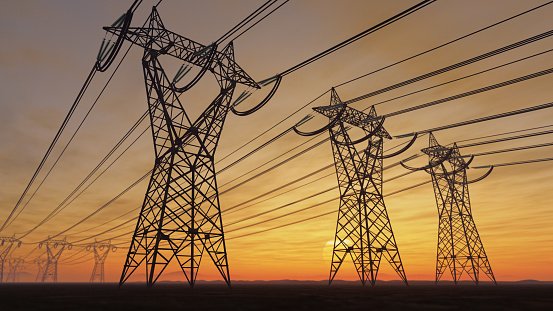In 2021, China’s National Energy Administration (NEA) published its new plan to increase renewable power purchase by regional grid firms to 40% by 2030, to facilitate China’s “carbon neutral” by 2060 and raise share of non-fossil fuels in primary energy consumption to around 25%” by 2030 target, set in the year of 2020.
China’s clean energy power consumption targets
Source: China Energy Administration
Traditionally in China, energy resources are far away from the load centers; energy layout is characterized by “more in the north than south, more in the west than east”. The majority of the hydropower resources are in the southwest, and coal is in the northwest, wind power is in the west and north, but huge loadings are concentrated in the east and central part.

China Energy and Load Allocation
Source: State Grid of China,Zhongtai Securities
http://gdasc.cn/news_3319.shtml
Besides, the 500 kV electricity grid is limited in terms of long-distance and large-capacity electricity transmission, thus it is difficult to transfer the electricity from renewable resource locations to the load centers, resulting in the growth of coal electricity projects in the middle and east area, aggravating the challenging situation for coal supply, transport and environment protection.
UHV: a right answer at the right timing
Since 2006, these facts above drove power companies in China, including State Grid Corporation of China (SGCC), which is the largest utility company in the world to look for the solution to long-distance electricity transmission.
The application of UHV facilitates China to establish a nationwide super grid that interconnects China’s six regional grids and mediates the geographic differences between energy production areas and energy consumption locations. It also allows China to better utilize renewable energy nationally and transmit more clean energy to the load centers.
UHV application in China
Source: State Grid of China
China: a leading “latecomer”
Until now, 26 UHV projects have been constructed and commissioned by State Grid alone, five UHV projects have been approved and are under construction. This is not only motivated by growing market demand, but also driven by national policies actively pushing this process forward.

Projects In Operation and Under Construction by State Grid
Source: State Grid
In 2011, the UHV project was included in the 12th Five Years Plan of China. In 2020, UHV transmission grids are proposed as one of the “new infrastructures” in China, in which the government decided to accelerate investment, even with COVID impact on the country’s economy; 14 UHV projects were planned to be developed by the two largest transmission company, SGCC and China Southern Power Grid (CSG); the total size of investments in these UHV projects estimates to be $26.8 bn, which signals that China stepped into another stage of UHV expansion.
Technical issues were one of the key barriers blocking the development of UHV technology for the countries which gave up UHV development, along with the political and economic reasons. With the firm policy support from China government and continuous investment in technical innovation, China has been carrying out UHV technical research since 1980s, and finally succeeded in the design and test of 1000 kV transformer (the key equipment for UHV) in 2008, followed by more key equipment development afterwards.
Clean Energy on the Road: From China to Brazil
Companies like SGCC started to invest and construct several UHV projects overseas. Among these, the Belo Monte II ultra-high-voltage (UHV) transmission project embarked 2010 in Brazil is a good example of its application scenario globally. With a designed transmission capacity of 4 million kwh, adopting ±800 UHV DC transmission program, and crossing over 2500 km length, this is the first overseas UHV project implemented by SGCC.
Similar to China, Brazil has a vast land, the power plants are located far away from the populated areas. While 80 percent of Brazil’s electricity is used by the more developed areas in southern and southeastern parts of the country, main power plants are located in the north, more than 2,000 kilometers away.
Workers construct power lines for Belo Monte UHVDC Bipole II, the longest
±800kV UHVDC transmission project in the world
Source: State Grid
UHV: Backbone for Global Energy Internet
At the 2014 meeting of the Institute of Electrical and Electronic Engineers (IEEE) power and Energy Association, Liu Zhenya, the chairman of the SGCC, published a signed article entitled “building a global energy Internet to serve the sustainable development of human society”, proposing a vision of building global energy Internet to better utilize clean energy around the world efficiently, and achieve sustainable development.
Zhenya Liu proposed that the international energy Internet will be constituted by transcontinental and transnational interconnection backbone and country-based ubiquitous smart grid, enabling transporting clean energy such as wind power, solar power and ocean energy, which is a safe, reliable and green global energy allocation platform. He believes the international energy Internet is the direction of the global energy transition.
From the perspective of regional development, the new round of UHV construction can optimize the balance between regional energy supply and demand. The transmission of surplus power to the high-demand areas can mitigate the inequality of electricity. This also applies to some countries with similar characteristics as China: vast land and imbalance between power supply and demand.
Therefore, the outlook of the application of UHV is highly expected——grid expansion could provide better transmission channels for the world’s massive renewable power resources, leading to a sustainable energy transition.
Although UHV is not a perfect solution for all, it’s definitely an advanced option, just like the highway obsoleted the muddy road, especially in the sense of building a cleaner world.
by Sai Ying, Lei Haoyue, Jiang Jinhao
References:
[1] Muyu Xu, David Stanway (2021). Reuters. China plans to raise minimum renewable power purchase to 40% by 2030: government document. https://www.reuters.com/article/us-china-climatechange-renewables-idUSKBN2AA0BA
[2] 杜至刚,赵建国 (2008). 中国特高压电网发展战略规划研究. https://xuewen.cnki.net/CDFD-2008189974.nh.html
[3] China DIalogue (2018). Sparks fly over ultra-high voltage power lines. https://chinadialogue.net/en/energy/10376-sparks-fly-over-ultra-high-voltage-power-lines/
[4] IEEE SPECTRUM (2019). China’s Ambitious Plan to Build the World’s Biggest Supergrid. https://spectrum.ieee.org/chinas-ambitious-plan-to-build-the-worlds-biggest-supergrid
[5] State Grid (2021). UHV. http://www.sgcc.com.cn/html/sgcc_main/col2017041259/column_2017041259_1.shtml
[6] 国民经济和社会发展第十二个五年规划纲要全文(2012).http://www.gov.cn/2012lh/content_2054667_4.htm
[7] Power Technology (2020). China Develops $26bn Ultra High Voltage Electrical Grids to Stimulate Economic Recovery. https://www.power-technology.com/comment/china-26bn-uhv-grids/
[8] 国际能源网(2020). 中国特高压特别之处. https://zhuanlan.zhihu.com/p/215762538?utm_source=wechat_session&utm_medium=social&utm_oi=861177214958460928
[9] 瞭望(2020). 为什么中国在特高压领域能后来居上. http://lw.xinhuanet.com/2020-12/07/c_139570177.htm
[10] Global Times (2021). China’s State Grid: Linking North and South of Brazil. https://www.globaltimes.cn/page/202108/1232633.shtml
[11] Zhenya Liu (2015). Global Energy Interconnection. Elsevier.
[12] 新华社(2015). 全球能源互联网 破解之路? http://www.xinhuanet.com/energy/zt/nyxgc/28.htm
[13] A Wang, YU Zhu, R Guan, ZW Chen, LQ Zhao (2014). High Voltage Transmission Line Electromagnetic Environment Analysis and Research on the Human Body Biological Effect. ResearchGate
[14] Chen, W.X.(2009) Coal transportation or ultrahigh-voltage? (in Chinese)







This is my first time pay a visit at here and i am actually happy to
read all at one place.